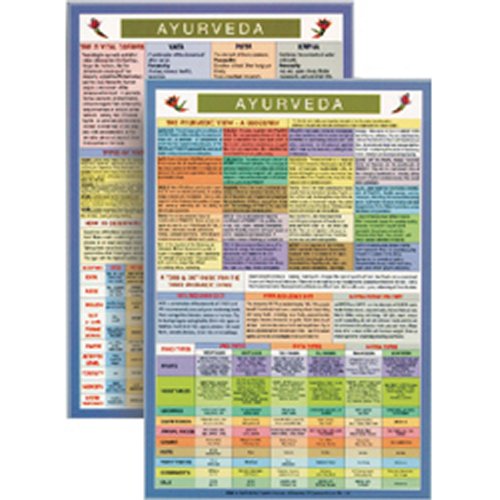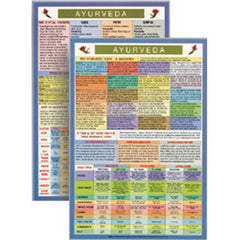

Ayurveda Mini Chart
- $9.95 USD
$11.95 USD- $9.95 USD
- Unit price
- per
Learn about Ayurveda the easy way! The user friendly Ayurveda Mini Chart explains the three constitutional types, lists ayurvedic terminology, yes and no foods for the three types and much more.
Ayurveda is grounded in a metaphysics of the 'five great Elements' earth, water, fire, air and ether - all of which compose the Universe, including the human body. Chyle or plasma, blood, flesh, fat, bone, marrow, and semen or female reproductive tissue are held to be the seven primary constituent elements of the body. Ayurveda deals elaborately with measures of healthful living during the entire span of life and its various phases.
Ayurveda stresses a balance of three Humors or Energies: vata (air in space - wind), pitta (fire in water -bile) and kapha (water in earth -phlegm). According to Ayurveda, these three regulatory principles— Doshas (literally that which deteriorates - Devanāgarī - are important for health, because when they are in balanced state, the body is healthy, and when imbalanced, the body has diseases. Ayurveda hold that each human possesses a unique combination of Doshas.
In Ayurveda, the human body perceives attributes of experiences as 20 Guna (meaning qualities). Surgery and surgical instruments are employed. It is believed that building a healthy metabolic system, attaining good digestion, and proper excretion leads to vitality. Ayurveda also focuses on exercise, yoga, meditation, and massage. Thus, body, mind, and spirit/consciousness need to be addressed both individually and in unison for health to ensue.
The Ayurveda Mini Chart measures 9.25 x 6.25" (235 x 160mm) in size.
Note: The low resolution image shown has been purposely provided to protect copyright content of the chart. The chart you will receive is in an easy to read high resolution format.
Returns Policy
You may return most new, unopened items within 30 days of delivery for a full refund. We'll also pay the return shipping costs if the return is a result of our error (you received an incorrect or defective item, etc.).
You should expect to receive your refund within four weeks of giving your package to the return shipper, however, in many cases you will receive a refund more quickly. This time period includes the transit time for us to receive your return from the shipper (5 to 10 business days), the time it takes us to process your return once we receive it (3 to 5 business days), and the time it takes your bank to process our refund request (5 to 10 business days).
If you need to return an item, simply login to your account, view the order using the "Complete Orders" link under the My Account menu and click the Return Item(s) button. We'll notify you via e-mail of your refund once we've received and processed the returned item.
Shipping
We can ship to virtually any address in the world. Note that there are restrictions on some products, and some products cannot be shipped to international destinations.
When you place an order, we will estimate shipping and delivery dates for you based on the availability of your items and the shipping options you choose. Depending on the shipping provider you choose, shipping date estimates may appear on the shipping quotes page.
Please also note that the shipping rates for many items we sell are weight-based. The weight of any such item can be found on its detail page. To reflect the policies of the shipping companies we use, all weights will be rounded up to the next full pound.
Related Products
- Choosing a selection results in a full page refresh.

